| Author |
Message |
|
Timo Nieminen
|
 Posted: Mon 14 Dec, 2015 11:09 pm Post subject: Show us your African swords Posted: Mon 14 Dec, 2015 11:09 pm Post subject: Show us your African swords |
 |
|
A whole continent of swords! Lots of variety! There are many distinctive regional types.
Broadly, we have North Africa, along the Mediterranean coast. Some North African swords are very international, due to Ottoman influence on swords in Africa, the Balkans, and elsewhere.
There is the Sahara, with characteristic swords like the kaskara and takouba.
https://en.wikipedia.org/wiki/Takoba
https://en.wikipedia.org/wiki/Kaskara
http://takouba.org/
There is the Horn of Africa, with distinctive types of swords from Ethiopia and Somalia.
Central African, dominated by the Congo basin, with a diverse range of swords.
West Africa (Cameroon, Nigeria, and west of there), with distinctive swords from various tribal groups such as the Manding/Mandingo.
East Africa, with classic swords of the Maasai/Masai, and also from elsewhere such as Tanzania.
South Africa, which appear to have fewer swords than the rest of Africa, but there are some.
Some books covering African weapons include:
Christopher Spring, African Arms and Armour, http://myArmoury.com/books/item.1560983175.html
A. C. Tirri, Islamic and Native Weapons of Colonial Africa: 1800-1960, http://myArmoury.com/books/item.0974719250.html
A whole bunch of books by Manfred Zirngibl, such as:
http://myArmoury.com/books/item.3875531981.html
http://myArmoury.com/books/item.3981125428.html
"In addition to being efficient, all pole arms were quite nice to look at." - Cherney Berg, A hideous history of weapons, Collier 1963.
|
|
   |
 |
|
Timo Nieminen
|
 Posted: Mon 14 Dec, 2015 11:30 pm Post subject: Posted: Mon 14 Dec, 2015 11:30 pm Post subject: |
 |
|
Central African, all from the Congo basin.
1. Ngombe/Ngbandi. Sickle sword. Double-edged, offset fullers (which you could think of as a Z-shaped cross-section). Blade is thin, about 4mm at the base, and 2.5mm at the bend. POB is 5.5" from the end of the grip. The grip is wrapped in copper wire. 575g.
2. Yakoma? (Ngombe?) Offset fullers, with 2 pairs of inlaid brass dots (I think they go all the way through the blade, rather than separate inlays on both sides). 5mm thick at the end of the ricasso, which is the thickest part of the blade, and 3.5mm thick at the pair of brass dots near the tip. POB 6.5", 630g. Wooden hilt.
3. Poto? (Doko? Ngombe?) Offset fullers; flip this over and it looks the same on the other side (the symmetric offset fullered blades generally do). 2.6mm ricasso, 2.5mm thick near the tip. POB at 5", 460g. Copper-wrapped grip.
4. Luba (southern Congo basin, Katanga). 6.8mm at the ricasso, 3.3mm thick at the broadest part of the blade. POB at 4", 445g. Hollow-ground (really, hollow-forged) diamond-hex-diamond section along the blade. Wooden hilt.
6. Ngombe/Ngbandi. Another sickle sword - this time with a flared tip. 3mm thick at the base, transitioning smoothly to 3.5mm at the base of the flare, and about that thick for most of the flared tip. Fuller on one side, and the other side is almost flat (with a convex transition to the edge; the edge is in the middle, not on the flat side), so an approximately fullered triangular cross-section. POB at 10", 580g. Grip was possibly originally copper-wrapped (now it is bare wood).
 Attachment: 92.28 KB Attachment: 92.28 KB
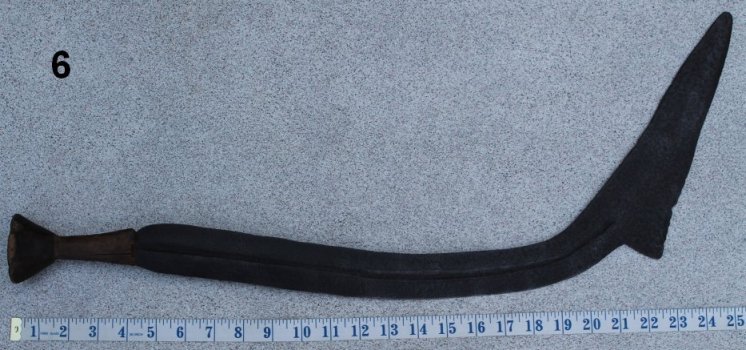
 Attachment: 72.24 KB Attachment: 72.24 KB

 Attachment: 60.81 KB Attachment: 60.81 KB

 Attachment: 67.84 KB Attachment: 67.84 KB

 Attachment: 67.39 KB Attachment: 67.39 KB
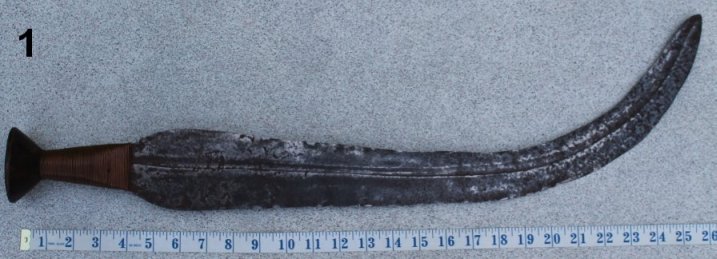
"In addition to being efficient, all pole arms were quite nice to look at." - Cherney Berg, A hideous history of weapons, Collier 1963.
|
|
   |
 |
|
Timo Nieminen
|
 Posted: Mon 14 Dec, 2015 11:32 pm Post subject: Posted: Mon 14 Dec, 2015 11:32 pm Post subject: |
 |
|
Chamba, collected 1980s NE Nigeria (the Chamba live in Nigeria and Cameroon). Probably a ritual object, rather than a fighting sword. All iron/steel. Diamond-section blade, 4.5mm thick at the base, 4mm thick near the tip. POB at 3", 360g. There are similar Chamba swords with curved blades:
http://takouba.org/catalog/index.php/other-sw...hort-sword
 Attachment: 58.8 KB Attachment: 58.8 KB

"In addition to being efficient, all pole arms were quite nice to look at." - Cherney Berg, A hideous history of weapons, Collier 1963.
Last edited by Timo Nieminen on Tue 15 Dec, 2015 1:42 am; edited 1 time in total
|
|
   |
 |
|
Timo Nieminen
|
 Posted: Mon 14 Dec, 2015 11:42 pm Post subject: Posted: Mon 14 Dec, 2015 11:42 pm Post subject: |
 |
|
East African. The classic Maasai/Masai sword, the "seme". The blade is very much like the blade on long-bladed Maasai lion-spears. Hollow-ground (hollow-forged) diamond section, 5.9mm at the base, and 5.5mm thick at the widest point near the tip. POB is at 6", the sword only is 500g, and 665g with the scabbard. The grip is rawhide, and the scabbard is thin wood covered in thin rawhide.
This one might be fairly old (early 20th century). Modern ones are often flat, rather than hollow diamond. Often made from machete blades. Blade length varies from about 12" though to well over 20".
 Attachment: 89.56 KB Attachment: 89.56 KB
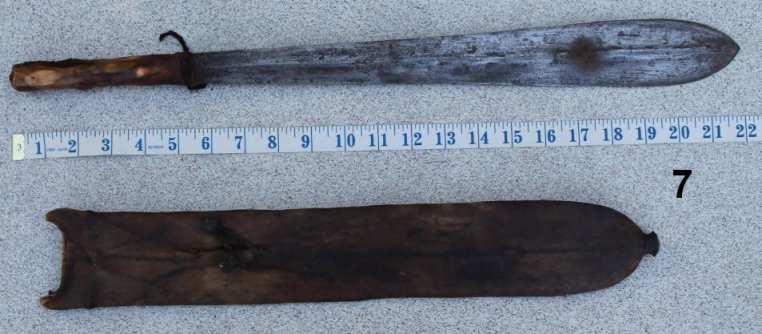
"In addition to being efficient, all pole arms were quite nice to look at." - Cherney Berg, A hideous history of weapons, Collier 1963.
|
|
   |
 |
|
Jeffrey Faulk
|
 Posted: Tue 15 Dec, 2015 7:40 am Post subject: Posted: Tue 15 Dec, 2015 7:40 am Post subject: |
 |
|
|
A lovely collection. I've always regretted that in all my time in Nigeria (I grew up there as my parents were missionaries) I never took the opportunity to pick up a proper takouba. It wouldn't have been an antique, but there were many vendors selling modern made ones. Ah well.
|
|
  |
 |
|
Iain Norman
|
 Posted: Thu 17 Dec, 2015 10:20 am Post subject: Posted: Thu 17 Dec, 2015 10:20 am Post subject: |
 |
|
Just a few of mine from the western Sahel region, commonly known as takouba. There's a range of blade ages here, all European from the 14th to the 18th century that I'll show over the next few posts.
Thanks for linking to my site Timo, glad to know it has some readers!
The first one with an Italian 16th century blade marked at the base and with the remains of an inlaid wolf.

|
|
  |
 |
|
Iain Norman
|
 Posted: Thu 17 Dec, 2015 10:27 am Post subject: Posted: Thu 17 Dec, 2015 10:27 am Post subject: |
 |
|
This one has a mid 14th century German blade with gold inlaid cross fourchee. It is mounted in a very sturdy forte.

|
|
  |
 |
|
Iain Norman
|
 Posted: Thu 17 Dec, 2015 10:30 am Post subject: Posted: Thu 17 Dec, 2015 10:30 am Post subject: |
 |
|
This one one has astral engravings on quite a slim and stiff blade. I haven't firmly dated it yet.

|
|
  |
 |
|
Iain Norman
|
 Posted: Thu 17 Dec, 2015 10:33 am Post subject: Posted: Thu 17 Dec, 2015 10:33 am Post subject: |
 |
|
A 17th century blade marked with globus cruciger and wolf. German.

|
|
  |
 |
|
Iain Norman
|
 Posted: Thu 17 Dec, 2015 10:35 am Post subject: Posted: Thu 17 Dec, 2015 10:35 am Post subject: |
 |
|
And a nice blade, likely 18th century and Italian. I have quite a few more but thought I'd just post a few for now.

|
|
  |
 |
David Cooper

|
 Posted: Thu 17 Dec, 2015 11:22 am Post subject: Kaskara Posted: Thu 17 Dec, 2015 11:22 am Post subject: Kaskara |
 |
|
The ubiquitous Sudanese Kaskara with crescent moon marks.
 Attachment: 169.7 KB Attachment: 169.7 KB

 Attachment: 415 KB Attachment: 415 KB
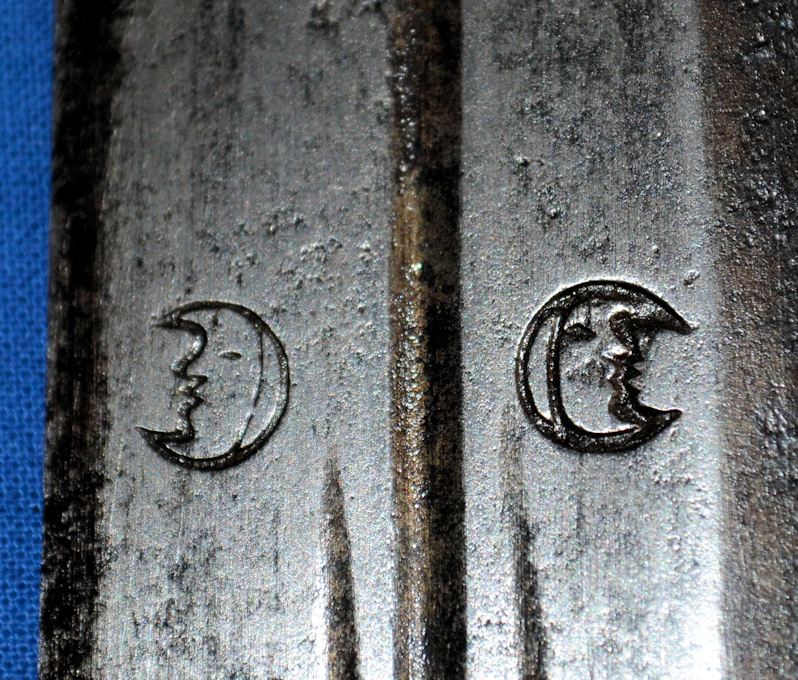
 Attachment: 452.17 KB Attachment: 452.17 KB
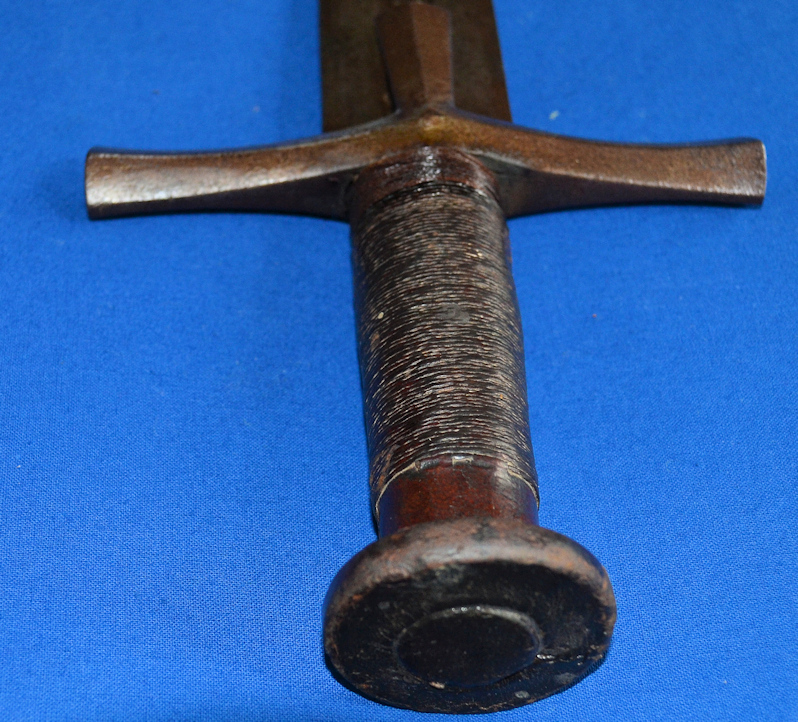
The journey not the destination
|
|
  |
 |
David Cooper

|
 Posted: Thu 17 Dec, 2015 11:39 am Post subject: West African Manding Short Sword Posted: Thu 17 Dec, 2015 11:39 am Post subject: West African Manding Short Sword |
 |
|
Still researching this one so if anyone has any comments or opinions please let rip. It is only tentatively identified as a West African Manding Short Sword. I am particularly interested to know if he exposed tang is intentional or if it should have a leather pommel cap attached.
 Attachment: 64.13 KB Attachment: 64.13 KB
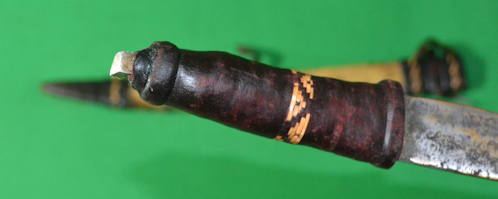
 Attachment: 348.57 KB Attachment: 348.57 KB
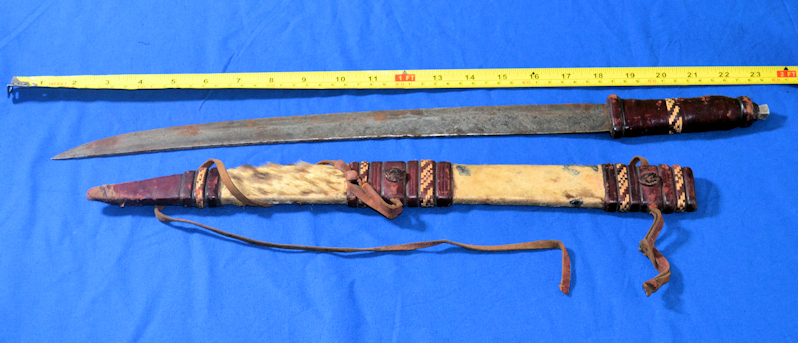
 Attachment: 247.7 KB Attachment: 247.7 KB
[ Download ]
 Attachment: 319.66 KB Attachment: 319.66 KB
[ Download ]
The journey not the destination
|
|
  |
 |
|
Iain Norman
|
 Posted: Thu 17 Dec, 2015 1:14 pm Post subject: Posted: Thu 17 Dec, 2015 1:14 pm Post subject: |
 |
|
A lovely kaskara example David, much better than most of the ones on the market these days!
The Manding sword, the nub is intentional. Many Manding swords feature a little pommel of brass.
|
|
  |
 |
|
Timo Nieminen
|
 Posted: Thu 17 Dec, 2015 1:46 pm Post subject: Re: West African Manding Short Sword Posted: Thu 17 Dec, 2015 1:46 pm Post subject: Re: West African Manding Short Sword |
 |
|
| David Cooper wrote: | | Still researching this one so if anyone has any comments or opinions please let rip. It is only tentatively identified as a West African Manding Short Sword. I am particularly interested to know if he exposed tang is intentional or if it should have a leather pommel cap attached. |
Usually, I see these with some kind of ornament/pommel on the end. From a fairly small rectangular brass piece, various brass knobs, through to what look like wooden balls. I've seen at least one other photo of one with an exposed tang like this, but they seem to be in a minority.
"In addition to being efficient, all pole arms were quite nice to look at." - Cherney Berg, A hideous history of weapons, Collier 1963.
|
|
   |
 |
|
Iain Norman
|
 Posted: Fri 18 Dec, 2015 3:16 am Post subject: Posted: Fri 18 Dec, 2015 3:16 am Post subject: |
 |
|
A rather unusual takouba for this post with a repousse silvered hilt. The decorative motif on the guard may well represent the type of shackles used in slaving. The blade is European and marked with a lion. Very beefy blade. The pommel originally had a silver cap as well, but sadly that's missing.

|
|
  |
 |
J. Nicolaysen

|
 Posted: Fri 18 Dec, 2015 6:34 am Post subject: Posted: Fri 18 Dec, 2015 6:34 am Post subject: |
 |
|
|
I have nothing to add but my appreciation to you guys for bringing out this thread and some great examples. I've only seen pictures of African weapons in books like Cameron, etc. This is a whole 'nother level. These Takouba are really cool. I had fun looking at your site Iain Norman. Very interesting and thanks again.
|
|
  |
 |
|
Iain Norman
|
 Posted: Fri 18 Dec, 2015 7:55 am Post subject: Posted: Fri 18 Dec, 2015 7:55 am Post subject: |
 |
|
Thanks for the kind comments, I'm glad the website proved interesting. I realize this is a bit of the scope of the usual topics on myArmoury but I think there's a lot more in common than many readers might realize, including a large amount of trade that actually went from the Sahel and the areas these takouba were used (modern day Mali, Nigeria, Niger) to Europe. Including so called Moroccan leather which was actually from Nigeria, not to mention large amounts of salt, gold and other goods.
On that topic, here's an entirely native example, this is a distinct style I've nicknamed wide blades for lack of a better term although in the local Hausa language it would be a Fatefate. The blade is flat, wide with decent flex and appears to be made from local iron ore. The hilt is brass and nicely decorated.

Just to give a little flavor of the locale and people who used these, here's an old photo of a Hausa gentleman with a similar sword.

|
|
  |
 |
|
Iain Norman
|
 Posted: Fri 18 Dec, 2015 8:46 am Post subject: Posted: Fri 18 Dec, 2015 8:46 am Post subject: |
 |
|
I thought it would be worth showing the most typical takouba style as well. The more or less ubiquitous triple fuller style. The best blades of this type are European and some much older than others, these were still being produced from Solingen into the 19th century.
This sword is from the border area between Nigeria and Cameroon and has a good sized iron pommel and leather wrapped grip/guard. The blade is one of the better triple fullers, quite broad and nicely marked with what is again almost a stereotype for takouba, man in the moon marks. This one I suspect is an 18th century Solingen product.
Chances are most takouba you see will follow this blade style, it is by far the most typical, whether for true European blades or the local copies which are still actually being made to this day. You'll notice that the form is very similar to the kaskara blade posted earlier in this thread. The older blades have a more rounded blade profile slopping from the center of the blade to the edge, while later mass produced Solingen products are a little more chunky and flat like the kaskara example.

|
|
  |
 |
|
Timo Nieminen
|
 Posted: Thu 21 Jan, 2016 12:37 am Post subject: Posted: Thu 21 Jan, 2016 12:37 am Post subject: |
 |
|
My first and currently only takouba. The inset shows the other side of the guard. This takouba looks late 20th century to me. Not sharp, and never has been. Hand-forged blade. 699g, 835g with the scabbard. The blade is 3.7mm thick at the base, 3.6mm mid-blade, and 3mm near the tip. POB is 6.25" from the guard. Forward pivot point (AKA centre of percussion) is about 1/3 of the way along the blade from point to guard. With that balance, works fine for sword and buckler, and for slashing.
 Attachment: 56.47 KB Attachment: 56.47 KB

"In addition to being efficient, all pole arms were quite nice to look at." - Cherney Berg, A hideous history of weapons, Collier 1963.
|
|
   |
 |
Randall Moffett

|
 Posted: Fri 22 Jan, 2016 6:57 pm Post subject: Posted: Fri 22 Jan, 2016 6:57 pm Post subject: |
 |
|
This is a great post. I am really enjoying learning and seeing more on these swords. So many amazing characteristics. I find it very interesting to see how region to region there is so much variation and some of the interesting similarities between these and other parts of the world.
I will have to read over this a few more times.
Thanks for putting these up.
RPM
|
|
  |
 |
|
|
You cannot post new topics in this forum
You cannot reply to topics in this forum
You cannot edit your posts in this forum
You cannot delete your posts in this forum
You cannot vote in polls in this forum
You cannot attach files in this forum
You can download files in this forum
|
All contents © Copyright 2003-2025 myArmoury.com — All rights reserved
Discussion forums powered by phpBB © The phpBB Group
Switch to the Basic Low-bandwidth Version of the forum
|

